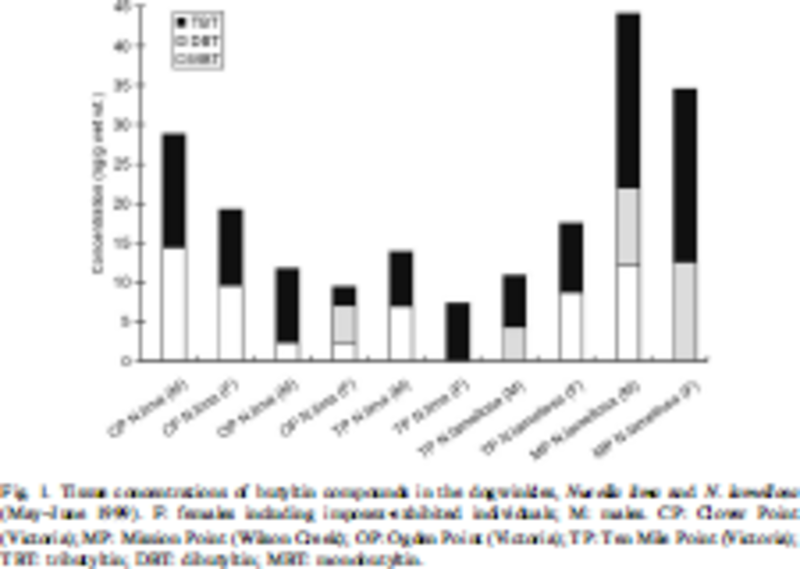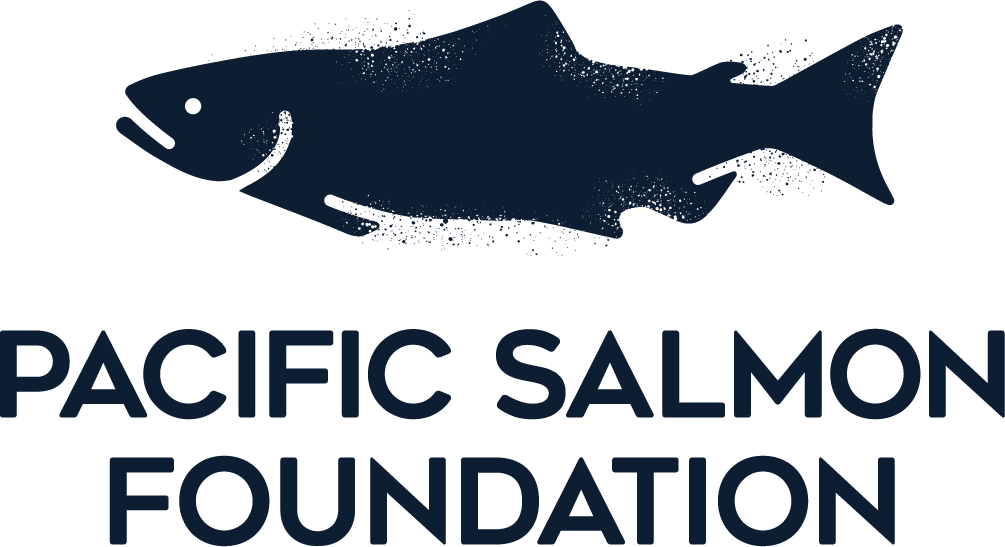Contamination of organotin compounds and imposex in molluscs from Vancouver, Canada
Gastropods and bivalves were collected at 15 sites at Vancouver and Victoria, Canada between 24 May and 7 June, 1999, to establish tissue concentrations of butyltin and phenyltin compounds, to record imposex symptoms in gastropods, and to assess the present status of organotin contamination around Vancouver.TBT was the most predominant butyltin component in almost all bivalve specimens surveyed, suggesting a low rate of TBT metabolism. Phenyltin compounds were not detected in any molluscan specimens in this study.
Simple
- Date (Publication)
- 2003
- Cited responsible party
-
Organisation name Individual name Electronic mail address Role DFO
Colin Levings
Principal investigator National Institute for Environmental Studies
T. Horiguchi
Principal investigator The Institute of Environmental Science & Engineering, The Ocean University of Qingdao
Z. Li
Principal investigator Mitsubishi Chemical Safety Institute, Kashima Laboratory
S. Uno
Principal investigator Graduate School of Agricultural and Life Sciences, The University of Tokyo
M. Shimizu
Principal investigator National Institute for Environmental Studies
H. Shiraishi
Principal investigator National Institute for Environmental Studies
M, Morita
Principal investigator 2WE Associates Consulting Ltd.
J.A.J. Thompson
Principal investigator
- Presentation form
- Digital document
- Name
-
Marine Environmental Research
- Issue identification
-
57
- Other citation details
-
0141-1136/$ - see front matter # 2003 Elsevier Ltd. All rights reserved. doi:10.1016/S0141-1136(03)00061-8
- Purpose
-
During the PICES Practical Workshop in Vancouver, Canada from May 24 to June 7, 1999, we studied imposex symptoms and tissue concentrations of organotin compounds, such as TBT, in gastropod specimens, and organotin concentrations in tissues of bivalve specimens from Vancouver and Victoria. The present status and temporal trends of imposex and organotin contamination in molluscs around Vancouver are also discussed, and it will be useful to gauge the success of Canadian regulation of TBT.
- Status
- Completed
- Maintenance and update frequency
- Not planned
-
Government of Canada Core Subject Thesaurus
-
-
Pollution
-
Pollution prevention
-
-
Global Change Master Directory (GCMD) Science Keywords v15.9
-
-
Earth Science > Biological Classification
-
Earth Science > Biological Classification > Animals/Invertebrates > Mollusks > Bivalves
-
Earth Science > Biological Classification > Animals/Invertebrates > Mollusks > Gastropods
-
-
DFO Areas
-
-
North Pacific Ocean > South Inner Coast(Johnstone Strait, Strait of Georgia, Juan de Fuca, inlets and passages)
-
-
DFO Areas
-
-
North Pacific Ocean > South Inner Coast(Johnstone Strait, Strait of Georgia, Juan de Fuca, inlets and passages)
-
- Language
-
English
- Character set
- UTF8
- Topic category
-
- Oceans
- Environment description
-
14 KB
- Description
-
15 sites around Vancouver and Victoria
))
- Begin
- 1999-05-27
- End
- 1999-06-07
- Supplemental Information
-
Gastropods and bivalves were collected at 15 sites at Vancouver and Victoria, Canada between 24 May and 7 June, 1999, to establish tissue concentrations of butyltin and phenyltin compounds, to record imposex symptoms in gastropods, and to assess the present status of organotin contamination around Vancouver. No neogastropods (such as Nucella lima) were found around Vancouver. Neogastropod populations could have been extirpated by severe TBT contamination in Vancouver, as relatively high concentrations of TBT were detected in tissues of Mytilus trossulus from Vancouver, and the neogastropods distributed in Vancouver might be sensitive to TBT. Recovery from imposex, however, was observed in neogastropod populations from three sites at Victoria and Mission Point. TBT contamination has continued around Vancouver, arising from continuous use of TBT in antifouling paints for vessels larger than 25 m in length; however, TBT has decreased around Victoria and Mission Point. Different patterns of TBT accumulation in tissue were observed among the bivalve species from Vancouver. The highest TBT concentration detected in Tresus capax suggested some possible adverse effects. TBT was the most predominant butyltin component in almost all bivalve specimens surveyed, suggesting a low rate of TBT metabolism. Phenyltin compounds were not detected in any molluscan specimens in this study.
- Distribution format
-
Name Version electronic
none
- Distributor contact
-
Organisation name Individual name Electronic mail address Role Pacific Salmon Foundation
Isobel Pearsall
Distributor
- OnLine resource
-
Protocol Linkage Name WWW:LINK-1.0-http--link
http://www.dfo-mpo.gc.ca/science/data-donnees/index-eng.html DFO Science website
WWW:DOWNLOAD-1.0-http--download https://soggy2.zoology.ubc.ca/geonetwork/srv/api/records/691cf37f-e4a5-4751-bc37-6e7133939e93/attachments/691cf37f-e4a5-4751-bc37-6e7133939e93.pdf Contamination of organotin compounds and imposex in molluscs from Vancouver, Canada
WWW:DOWNLOAD-1.0-http--download https://soggy2.zoology.ubc.ca/geonetwork/srv/api/records/691cf37f-e4a5-4751-bc37-6e7133939e93/attachments/691cf37f-e4a5-4751-bc37-6e7133939e93.xlsx Tables
- Hierarchy level
- Dataset
- Statement
-
Levings produced paper copy. Fraser scanned with Fujitsu Scansnap s1500 (ABBY Finereader OCR software). Data was extracted through Adobe Reader conversion and manual entry into MS Excel.
Metadata
- File identifier
- 691cf37f-e4a5-4751-bc37-6e7133939e93 XML
- Metadata language
-
eng
- Character set
- UTF8
- Hierarchy level
- Dataset
- Date stamp
- 2023-12-19T00:05:36.21Z
- Metadata standard name
-
North American Profile of ISO19115:2003 - Geographic information - Metadata
- Metadata standard version
-
NAP - CAN/CGSB-171.100-2009
- Metadata author
-
Organisation name Individual name Electronic mail address Role Pacific Salmon Foundation
Sarah Fraser
Author
- Other language
-
Language Character encoding French UTF8 English UTF8
Overviews

Spatial extent
))
Provided by
